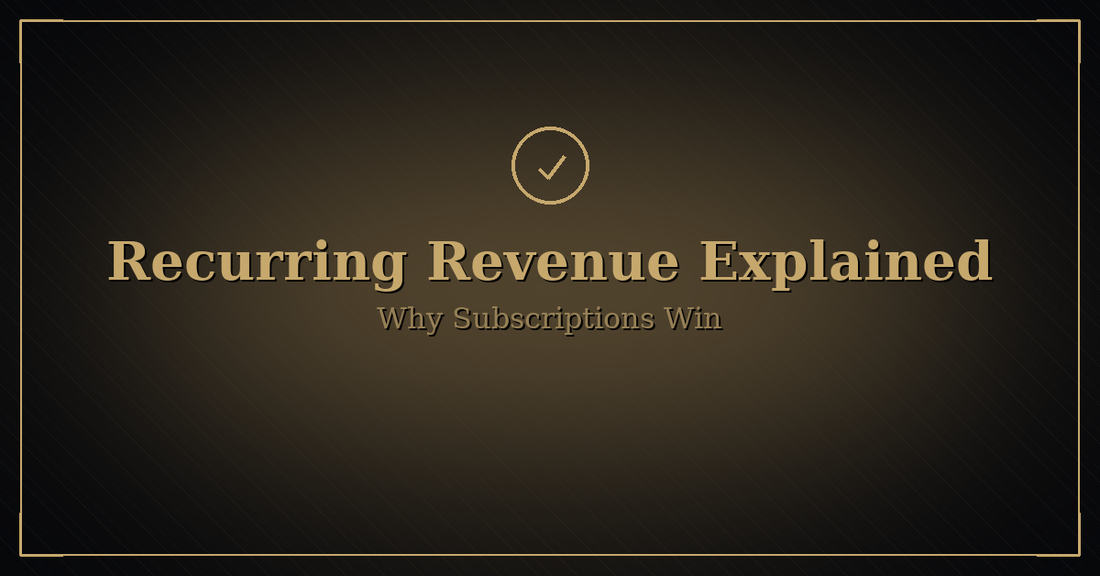
Recurring Revenue Explained: Why Subscriptions Win
Share
Recurring Revenue Explained: Why Subscriptions Win
Irregular sales make planning hard. Recurring revenue changes that. When a customer pays you monthly or annually—via a subscription business model, membership, or retainer—you trade one-off spikes for predictable cash flow and higher lifetime value. This guide breaks down the advantages, simple models you can launch, pricing that protects margins, the cash-flow mechanics behind MRR/ARR, and how to build retainers that last.
What recurring revenue actually means
Recurring revenue is income you can reasonably expect every billing period. In practice, you measure it with MRR (monthly recurring revenue) and ARR (annual recurring revenue). Two questions matter: how fast the base grows and how efficiently you grow it.
Growth quality shows up in a few core metrics. Churn rate tells you how quickly customers or revenue leak out; lower is better. Expansion revenue—from upgrades, add-ons, or extra seats—can more than offset churn and create net revenue retention above 100%, which means your base grows even without new customers. On the efficiency side, aim for an LTV/CAC ratio of 3:1 or better and a payback period under twelve months; annual prepay often accelerates that payback. If these terms sound abstract, think of them like this: keep customers long enough and deliver enough ongoing value that each cohort pays back acquisition spend and then compounds.
Why subscriptions win—for you and your customers
The business case is simple. Predictable cash flow lets you plan inventory, hiring, and marketing without gambling. It also tends to command better valuations because future earnings are easier to forecast. Customers benefit too: they get continuous improvements, reliable support, and a relationship built on outcomes instead of one-off transactions. Operationally, recurring touchpoints give you faster feedback loops; every billing cycle is a chance to learn, refine, and expand value. That cycle—retain, learn, improve, expand—is why well-run subscriptions, memberships, and retainers keep compounding.
Simple models you can launch
Subscriptions
Offer ongoing value people don’t want to lose: software features, premium content, templates, community access, or replenishment for consumables. Keep the promise clear, the delivery cadence consistent, and the first value fast.
Memberships
Layer benefits by tier—basic resources at entry level, deeper libraries and office hours in the middle, premium coaching or exclusive access at the top. Your value ladder nudges natural upgrades without pressure.
Retainers (productized services)
Package outcomes with defined scope and standards. “Up to X requests per month with Y-day turnaround” is clearer than selling hours. Price the result, not the time.
Hybrid or usage-based with a base fee
A platform fee covers access and support; usage handles variable costs. Add caps and alerts to prevent bill shock.
Care, maintenance, and warranty plans
Post-purchase care extends product lifespan, reduces risk for the buyer, and creates a predictable revenue stream for you.
Pricing that protects margins
Start with the outcome the buyer cares about—time saved, risk reduced, revenue increased—and price against that value. Three clean tiers (good/better/best) reduce decision friction, with a clearly marked “most popular” middle tier to anchor comparisons. Offer both monthly and annual plans; a 10–20% annual discount pulls cash forward and often reduces churn. If onboarding is heavy, a setup fee is fair—but make deliverables explicit. Grandfather loyal customers when you raise prices and give them a clear upgrade path. Keep packaging modular with add-ons and per-seat pricing so customers can scale usage without switching.
Cash flow: from chaos to control
Understand the difference between cash and revenue recognition. Annual prepay boosts cash today, but you deliver and recognize value over time. Model MRR growth by cohort so you can forecast hiring and ad spend with discipline. Watch involuntary churn caused by failed payments; dunning (smart retries, friendly prompts, card-updater services) often saves more revenue than another discount campaign. The gold standard is negative churn: when upgrades and expansion revenue outpace downgrades and cancellations, the base grows on its own momentum.
Retainers that last
Durable retainers are built on clarity and cadence. Set edges on scope—what’s included, what isn’t, and how change requests work—so promise and delivery match. Publish service-level expectations for response times and turnaround. Tie your work to outcome-led KPIs the client recognizes, not internal activity metrics. Meet on a set rhythm, and run quarterly reviews to reset priorities and surface wins. Offer pauses and downgrade paths; a pause is better than a cancel. And every month, show proof of value in one page: what was achieved, what’s next, and what decision is needed.
A 30-day launch plan
In week one, define a single painful job-to-be-done and craft a clear promise tied to a business outcome. Draft three tiers and a couple of add-ons, then map an onboarding path that gets customers to first value within 24–72 hours.
Week two is pricing and billing. Decide your annual discount, set up checkout, tax/VAT, invoices, and dunning. Make sure cancellation, pause, and upgrade paths are obvious and fair.
Week three is delivery. Build only what’s essential for the first cohort. Create a simple activation checklist and a before/after scorecard so results are objective.
In week four, invite 10–20 ideal customers at a fair founder rate. Measure activation time, first value, and early churn reasons. Adjust scope, messaging, and packaging based on what you learn, not what you assumed.
Quick answers to common questions
Is my offer a fit for subscriptions?
If the value recurs—updates, support, replenishment, community, or ongoing insights—the model fits. For one-off transformations, consider maintenance plans or a paid community instead of forcing a subscription.
What’s a good churn rate?
It varies by segment and price point. For SMB subscriptions, single-digit monthly churn is a solid target; for enterprise, expect lower. Track logo churn and revenue churn separately so expansion doesn’t hide customer loss.
Should I discount to grow faster?
Use targeted incentives—free trials, founder pricing, or annual discounts tied to clear value. Avoid deep permanent discounts that anchor you at low margins.
How do I reduce failed payments?
Automate retries, notify customers in-app and via email, and collect backup payment methods during checkout. Monitor involuntary churn monthly.
Cross-promo: build your durable base with The Steady Game
If you want a practical, field-tested plan to design subscriptions, memberships, and retainers that customers keep for years, read The Steady Game. Inside you’ll find step-by-step packaging templates, renewal playbooks, cash-flow planning for MRR/ARR, and retention tactics that can lift net revenue retention above 100% without gimmicks.
Bottom line
Subscriptions win because incentives finally align. Deliver real, continuous value, and customers stay; when they stay, recurring revenue compounds. Choose a simple subscription business model or retainer, package it cleanly, price for outcomes, and protect the base with great onboarding and proactive retention. Do that consistently, and your cash flow becomes steady enough to plan, hire, and grow with confidence.
